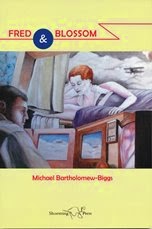The history of the aeroplane becomes the third character in Fred and Blossom’s story in this tender, largely biographical collection. From the outset Fred and Blossom were bound to collide even though they grew up in very different worlds. Blossom came from show business: ‘born backstage and cradled in a costume basket’ while Fred’s father owned a laundry business. Part of the work’s charm is its layout – the opening poem places details about the two side-by-side suggesting the inevitability of the two lives joining. Similarly the birth of the flying machine is mentioned on the same page emphasising the link between them. The useful notes at the back of the collection tells that the characters are real and this is indeed their biography. Such knowledge draws us closer to Fred and Blossom as their lives are revealed.
We are shown Fred and Blossom’s early years including Blossom’s misfortune of she losing an eye as a reaction to vaccination. The characters’ lives are not without sadness yet what stops the poems from being maudlin is a skilfully deployed optimistic tone through the collection, reflecting the philosophical attitude of the players to what fate throws at them.
Bartholomew-Biggs does well to twine the characters’ lives alongside the development of flight in the 20th Century. As Fred makes his career in the nascent aircraft industry what is revealed is a great deal of aviation history, which comes alive when linked to the lives of Fred and indeed Blossom. In Learning to Fly we are shown the thrill experienced by the woman as ‘today she is learning to fly’. This is all the more contrasted by her Second World War experience when she and many women like her were discouraged from flying or indeed, designing. A found poem based on an article on women and flight from a 1939 issue of The Aeroplane clearly reveals how galling this must have been for Blossom: ‘the menace is the woman who thinks she ought to be flying a high speed bomber when she really has not the intelligence to scrub the floor of a hospital properly.’
Blossom’s life is perhaps the most extraordinary, as she, notwithstanding her partial-sightedness, becomes a keen aviator herself. Moreover it is revealed that she became integral to the design of aircraft. Bartholomew- Biggs emphasises the ramshackle held-together-with-string details of the first planes and the danger involved in flying such planes. The history of the plane reaches its climax in the Second World War and the poems dealing with this are charmingly nostalgic, not least the poem Workers Playtime which skilfully uses the idioms of the announcer and the responses of the workers revealing a good ear for realistic dialogue.
When Blossom learns to fly with Fred as her instructor, the two fall in love. There are obstacles, as with all great love affairs, not least the fact that she is already married. But running parallel with their love affair is their love for flight and aeroplanes. After the war, Fred continues to work in aviation however the poem Fred takes a back seat is touching in its gentle sadness – a sense that Fred has been side-lined in the firm he works, whilst Blossom is consigned to the role of wife and mother. The narrative then reveals that the company goes bankrupt and the poem Disused aerodrome 1963 is a fine tribute to all the disused airfields now lying quietly around the country.
The final section of the collection deals with other aspects of aviation history outside the dominant narrative. Interesting as they are and indeed skilfully executed, I feel they are mopping-up poems that did not fit the driving narrative and as such seem a little superfluous.
Order your copy of Fred and Blossom by Michael Bartholomew-Biggs (Shoestring Press £9) Here

